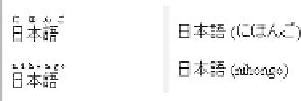HTML and CSS Reference
In-Depth Information
Note
• Other browsers do not position the ruby text element (
rt
) but instead move the
rt
content above the text it is associated with; thus, these browsers are not listed as
supporting
rt
. The purpose of the
rp
element is to show the grouping parentheses
in such nonsupporting browsers, so in some sense all browsers support this
element.
Ruby
No Ruby
<rt> (Ruby Text)
This initially Microsoft-specific proprietary element, now part of HTML5 and XHTML 1.1,
is used within a
<ruby>
tag to create
ruby text
, or annotations or pronunciation guides for
words and phrases. The base text should be enclosed in a
<ruby>
tag; the annotation,
enclosed in an
<rt>
tag, will appear as smaller text above the base text. Ruby parentheses
should be set with
<rp>
tags to provide fallback for browsers without ruby support.
HTML5 Standard Syntax
<rt
accesskey="spaced list of accelerator key(s)"
class="class name(s)"
contenteditable="true | false | inherit"
contextmenu="id of menu"
data-X="user-defined data"
dir="ltr | rtl"
draggable="true | false | auto"
hidden="hidden"
id="unique alphanumeric identifier"
itemid="microdata id in URL format"
itemprop="microdata value"
itemref="space-separated list of IDs that may contain microdata"
itemscope="itemscope"
itemtype="microdata type in URL format"
lang="language code"
spellcheck="true | false"
style="style information"
title="advisory text"
tabindex="number">
</rt>
Syntax (Defined by Microsoft)
<rt
accesskey="key" (5)
class="class name(s)" (5)


